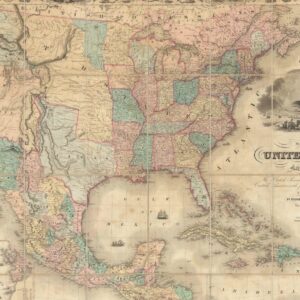The Colton Mapmaking Company was a prominent family firm of cartographic printers, who in the nineteenth century were leaders in the American map trade. Its founder, Joseph Hutchins Colton (1800-1893), was a Massachusetts native who in 1830 moved to New York City and slowly began setting up his publishing business, which in the beginning drew heavily on licensing maps by established engravers such as David H. Burr, Samuel Stiles & Company, and later Stiles, Sherman & Smith. Smith was a charter member of the American Geographical and Statistical Society, as was John Disturnell. This connection would later benefit Colton, in that it helped him to acquire the rights to several important maps.
By the 1840s, the Colton firm were producing their own maps. They produced anything the markets desired, from massive and impressive wall-maps to pockets guides, folding maps, immigrant guides, and atlases. One of the things that set the Colton company aside from many of its contemporaries in terms of quality, was the insistence that only steel plate engravings be used for Colton maps. These created much more well-defined print lines, allowing even minute features and labels to stand out clearly. By 1850, the Colton firm was one of the primary publishers of guidebooks, immigration itineraries, and railroad maps in America.
In the 1850s, Colton’s two sons, George Woolworth and Charles B., were brought on board to the firm. This inaugurated a process of expansion in which the company began taking international commissions and producing wholly independent maps and charts. From 1850 to the early 1890s, they also published several school atlases and pocket maps. The firm continued until the late 1890s, when it merged with a competitor and then ceased to trade under the name Colton.
-
-
Add to cartQuick View
- Atlases & Books, California, Texas and The West
Map of California, Oregon, Texas, and the territories adjoining, with routes &c.
- $1,900
- Colton’s iconic map of the West, with California Gold region and extended Texas borders.
-
Add to cart
Archived
- Out of Stock
- Texas and The West, United States
Map of the United States of America, the British Provinces, Mexico, the West Indies, and Central America: with part of New Granada and Venezuela.
- Colton’s seminal 1849 map of the United States: an encapsulation of the pivotal political developments of the 1840s.
- Read moreQuick View
-
- Out of Stock
- East & Midwest United States
Guide through Ohio, Michigan, Indiana, Illinois, Missouri, Wisconsin & Iowa
- A colorful map of the greater Midwest that provided first-time visitors and immigrants with the necessary overview of America’s new states.
- Read moreQuick View
-
- Out of Stock
- Texas and The West, United States
Map of the United States of America, the British provinces, Mexico, the West Indies and Central America with part of New Granada and Venezuela
- A map of American potential; a map that points towards a great, but still unfulfilled future.
- Read moreQuick View
-
- Out of Stock
- North America, United States
Colton’s Map of the United States of America, The British Provinces, Mexico and The West Indies Showing the Countries From the Atlantic to the Pacific Ocean
- Colton’s spectacular wall map of a rapidly expanding America.
- Read moreQuick View
-
- Out of Stock
- United States
Colton’s Map of the United States of America Showing the Country from the Atlantic to the Pacific
- G.W. & C.B. Colton's first U.S.-centric coast-to-coast map of the United States.
- Read moreQuick View
-








